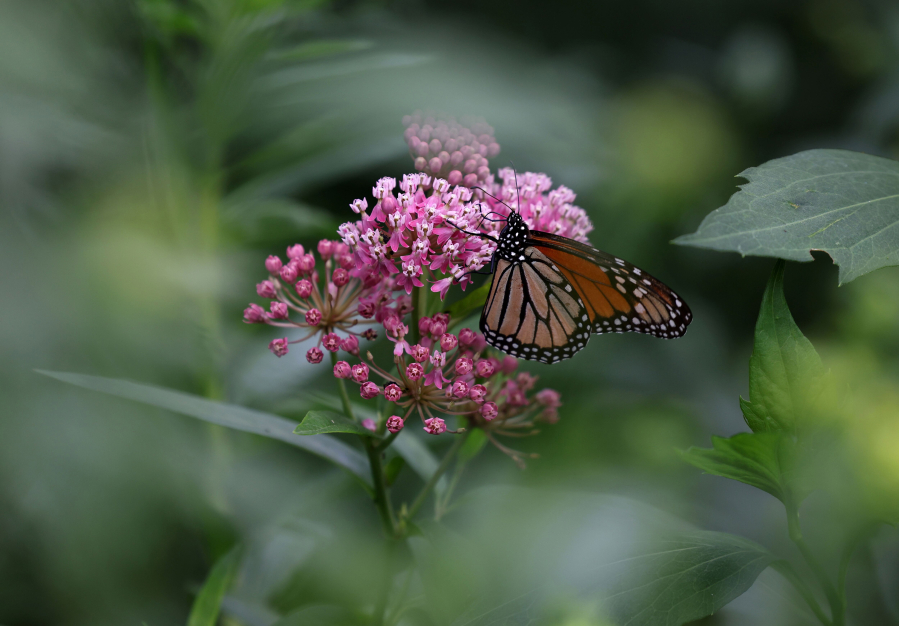CHICAGO — On a suburban street with smooth lawns and trimmed bushes, Martha Chiplis’ yard stands out. It’s not just the wildflowers: purple wild petunia, golden lanceleaf coreopsis, hot-pink Bush’s poppy mallow. It’s the lemon-yellow goldfinches that snack on the seeds, the fluffy bees that feed on the blooms.
And then there’s the star of the show: a monarch butterfly that descends within minutes.
The orange and black showstopper flies low and circles twice, so close that you can almost reach out and touch it.
“Oh! Yea!” says Chiplis, 58, of Berwyn. “They’ve been flying around all morning.”
At a time when monarch butterflies are struggling for survival, Chiplis is one of over 400 home gardeners throughout the Chicago area who have participated in a four-year Field Museum research project aimed at understanding how urban areas can provide much-needed habitat for the iconic insects.
The gardeners, who range from beginners with one milkweed plant to veterans with hundreds, have collected detailed data on monarchs, eggs and caterpillars in their yards, decks, community gardens and balconies — contributing up to 1,800 records each summer.
“We hope when we publish that it will show that these gardens can support (monarchs),” said Karen Klinger, a geographic information systems analyst at the Field Museum. “It depends on the year, but one year people saw 7,000 eggs. So there are butterflies that are coming out of these native gardens.”
With experts calling for an “all hands on deck” approach to saving the monarch that includes planting milkweed in parks, agricultural areas and rights of way, Field Museum researchers, who concluded the garden-monitoring phase of their work in 2022, are now analyzing data that they hope will contribute to our understanding of how much private citizens’ backyard milkweed plantings can do for monarchs.
Klinger and Field Museum lead conservation ecologist Aster Hasle were among the co-authors of a 2019 study in Frontiers in Ecology and Evolution that found that four large metro areas, including Chicagoland, have higher amounts of milkweed than previously assumed.
The researchers, who did random sampling of existing milkweed, estimated that the Chicago area had 15.3 million stems. And they found that there was enough available green space here — much of it lawn — to add 1.4 million stems of milkweed if just 2 percent of all owners of available green space planted a reasonable amount of milkweed.
That’s important at a time when experts say that planting milkweed is vital to the survival of the Eastern monarch population, which is estimated to be down by more than 80 percent since the 1990s.
“Cities could provide up to one-third of the milkweed thought to be needed to stabilize the population,” said Hasle.
Hasle and Klinger couldn’t get into peoples’ backyards to count milkweed for the 2019 study, so they decided to recruit volunteers who would help them understand more about that aspect of the monarch survival puzzle.
“There is a huge opportunity,” for researchers to learn from residential gardens, Hasle said.
Small gardens draw monarchs
Monarch fever builds in Chicago in mid-September, when butterflies migrating to Mexico typically pass through the region in large numbers, settling on trees by the hundreds.
But Eastern monarchs, which in some cases make that remarkable journey of up to 3,000 miles, have been in steep decline since the 1990s, when pesticide use in farm fields destroyed milkweed, the plant where the insect lays virtually all of its eggs.
With the monarch qualifying for federal endangered status in 2020 — although not yet obtaining it, due to a wait list — planting milkweed has been embraced by scientists, citizens, nonprofits and government agencies.
Parks, nature preserves, agricultural areas and rights of way have all been targeted. But the call has also gone out to people who garden at home, and some research indicates that home gardens are promising sources of monarch habitat.
As recently as 2015, a lot of people thought you couldn’t grow native plants in pots, Hasle said, but study participants grew milkweed on balconies.
One gardener took photos of milkweed in a single plastic pot — straight from the plant store. The plant hosted a caterpillar, then a chrysalis — a green podlike structure in which a caterpillar matures into a butterfly — and then an adult butterfly.
Another study participant, who lived in a condo building, grew milkweed on the roof.
“The number of caterpillars on those plants was amazing,” Klinger said.



